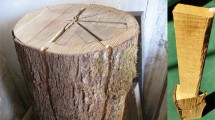Abstract
Stereological methods for the volume estimation of resin pockets in saw logs were studied using computed tomography (CT) and image analysis. The Cavalieri theorem was applied for transverse sections and the Pappus theorem was applied for longitudinal radial sections. Stereology applied on wood has to consider both the linear orientation of tracheids and rays, and the circular, lamellar oriented structure of annual rings. The precision of the estimates is illustrated with varying step length between sections, i.e. varying sample size and sampling intensity. To estimate the volume of resin pockets in one log with a coefficient of error of less than 10% requires a step length of 80 mm between transverse sections or ten radial longitudinal sections 18 degrees apart. Here, the resolution of 1.37 x 1.37 x 5 mm overestimated the true volume of resin pockets. Large resin pockets can be detected, whereas detection of small resin pockets, which involved differentiation between resin pockets and compression wood, was difficult with the CT-scanner. This study proves that implementation of stereology on wood can be a good tool for quantitative analysis of resin pockets, which also means that the methods are suited for effective quality control of resin pockets in sawn timber
Zusammenfassung
Stereologische Methoden zum Erfassen des Volumens von Harztaschen wurden an CT-Bildern mit Hilfe yon Bildanalysetechniken untersucht. Für Querschnitte wurde das Cavalieri-Theorem, für Längsschnitte das Pappus-Theorem angewendet. Die Stereologie yon Holz muff sowohl die lineare Orientierung der Tracheiden und Holzstrahlen als auch die ringförmige Lamellenstruktur der Jahrringe berticksichtigen. Die Genauigkeit der Schätzung wird anhand verschiedener Schrittweiten der Scans belegt, d.h. durch unterschiedliche Probengröße und Scandichte. Zur Schätzung des Volumens einer Harztasche in einem Rundholz mit einer Fehlerrate unter 10% erfordert eine Schrittlänge yon 80 mm zwischen den Querschnitten oder 10 radiale Längsschnitte in Schritten von je 18°. In dieser Studie war bereits eine Aufl6sung von 1,37 x 5 mm mehr als ausreichend. Große Harztaschen sind gut erkennbar, während kleine Harztaschen, die eine Differenzierung von etwaigem Druckholz erfordern, schwierig mit CT-Scannern zu erfassen sind. Die Arbeit zeigt, daß stereologische Methoden gut zur quantitativen Bildanalyse eingesetzt werden können,, d.h. daß sie sich auch für eine effektive Kontrolle yon Schnittholz (im Hinblick auf Harztaschen) eignen.
Similar content being viewed by others
References
Anonymus (1996) The manual to the NIH Image (Version 1.58) (Image analysis shareware)
Cruz-Orive LM, Roberts N (1993) Unbiased volume estimation with coaxial sections: an application to the human bladder. J. Microsc. 170: 25–33
Cruz-Orive LM (1987) Stereology: recent solutions to old problems and a glimpse into the future. Proc. ICS VII Caen 1987. Acta Stereol. 6/III: 3–18.5
Gundersen HJG, Jensen EB (1987) The efficiency of systematic sampling in stereology and its prediction. J. Microsc. 147: 229–263
Ifju G (1982) Quantitative wood anatomy certain geometrical-statistical relationships. Wood. Fiber Sci. 15: 326–327
Lindgren LO (1991a) Medical CAT-scanning: X-ray absorption coefficients, CT-numbers and their relation to wood density. Wood Sci. Technol. 25: 341–349
Lindgren LO (1991b) The accuracy of medical CAT-scan images for non destructive density measurements in small volurfie elements within solid wood. Wood Sci. Technol. 25: 425–432
Lindgren O, Davies J, Wells P, Shadbolt P (1992) Non-destructive wood density distribution measurements using computed tomography. Holz Roh- Werkstoff 50: 295–299
Mayhew TM, Gundersen HJG (1996) ‘If you assume, you can make an ass out of u and me’: a decade of the disector for stereological counting of particles in 3D space. J. Anat. 188: 1–15
Pache JC, Roberts N, Zimmermann A, Vock P, Cruz-Orive LM (1993) Vertical LM sectioning and parallel CT scanning designs for stereology: application to human lung. J. Microsc. 170: 9–24
Roberts N, Cruz-Orive LM, Reid NMK, Brodie DA, Bourne M, Edwards RHT (1993) Unbiased estimation of human body composition by the Cavalieri method using magnetic resonance imaging. J. Microsc. 171: 239–253
Scheaffer RL, Mendenhall W, Ott L (1990) Elementary survey sampling, 4th edn. PWS-KENT Publishing Company, Boston. ISBN 0-534-92185-X
Temnerud E(1996) Pitch pockets in Picea abies: variation in amount, number and size within trees and within stand. Scand J. For. Res. 11: 164–173
Temnerud E (1997) The occurrence of resin pockets in sawlog populations of Picea abies [L.] Karst. from five geographic regions in Sweden. unpublished manuscript
Underwood EE (1970) Quantitative stereology. Addison-Wesley Publishing Company, Inc. Philippines
Weslien H (1993) Estimating size and amount of pitch pockets in roundwood. Swedish University of Agricultural Sciences, Dep. For. Prod., Research note 171. 15 pp. ISSN 0349-8913. (In Swedish with English summary)
Weslien H (1995) Size, quantity, and distribution of pitch pockets in saw log of spruce (Picea abies [L.] Karst.) from 26 stands in Sweden. Swedish University of Agricultural Sciences, Dep. For. Prod., Report 248, 36 pp. ISSN 0348-4599
Author information
Authors and Affiliations
Additional information
The authors thank the supervisors Prof. T. Nilsson, Ass. Prof. U. Olsson, Prof A. Persson, Dr J-E. Lindgren, T. Dr. O. Lindgren and Prof A. Grönlund for valuable comments on the manuscript. The authors also thank Hans Fryk for assistance in producing the figures and Dr Lars Bjarklund who let us use his “Maq”. This study is included in a larger project, “High-quality joinery wood of spruce. Factors behind the formation of pitch pockets in spruce”, financed by the Swedish Council for Forestry and Agricultural Research, the Swedish Sawmills’ Research Foundation and the Nordic Forest Research Co-operation Committee. A one week stereology course in Berne given by L.M. Cruz-Orive greatly stimulated and assisted this study.
Rights and permissions
About this article
Cite this article
Temnerud, E., Oja, J. A preliminary study on unbiased volume estimation of resin pockets using stereology to interpret CT-scanned images from one spruce log. Holz als Roh-und Werkstoff 56, 193–200 (1998). https://doi.org/10.1007/s001070050298
Issue Date:
DOI: https://doi.org/10.1007/s001070050298




